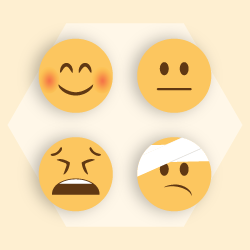the beginning of a recent therapy session, my client, a critical care nurse, requested that we explore the anger she felt when she was on social media as it related to wide-spread misinformation about Covid-19.
I asked, “What’s the worst part about feeling angry?”
Her response: “I can't do anything about it. I feel powerless.”
Powerlessness—an indicator of a stress injury.
Stress injury is a term to describe moments where the strain of a situation or event is too high and causes harm to the psyche.

As everyone manages stress differently, moments of injury are unique to each individual. These can be caused by specific events, or by the sheer quantity of events. Some experiences may leave us feeling injured even when similar situations don’t.
Which is what happened to my client. She had witnessed many things in the course of her career. But very few of them had left her wounded. Over the years, she has risen to challenges as a critical care nurse, coped with new stressors (including the pandemic), and pursued her life goals. Most people would look at her and think, “She’s got this, she’s tough, and she’s resilient.”
Which is the essence of what I told her:
“In terms of self-care, I’d say you’re doing everything right—”
But she wasn’t seeing a therapist just for fun.
“—which makes me think that this is more than righteous anger. You’ve done everything you can and more. Still, there’s contrast between what you’ve experienced and what is believed. Perhaps the powerlessness comes from not being able to reconcile the two. And it hurts.”
Assess Your Stress–Where Are You on the Stress Continuum?

Click here to identify how you and your teams can assess your stress levels and identify ways to manage them.
In many ways, I’m a pandemic therapist.
I had worked in health care for four years and was just starting to hone my skills in treating trauma when the pandemic started. By the time of this appointment, I knew how signs of it can hide in extremely resilient people.
Sometimes people hear “trauma” and they immediately associate it with a long-term mental illness like PTSD. Like many words in the wellness lexicon, it has been overused and underspecified.
Yet, it is vital that we find some way to recognize the emotional wounds that are harmful, painful, disruptive, and haunting long before they become PTSD. The Stress Continuum Model displays how one can move from readiness, to reacting, to injured, to ill–depending on the effectiveness of support.
A key difference between a stress reaction and a stress injury is that reactions go away. Experts say in ideal organizational settings, people would have access to consistent support throughout all stages of adverse events. These efforts often begin with “Stress First Aid,” emphasizing the importance of applying evidence-based techniques in moments of injury. And even with initial support, stress injuries often heal on their own. But that’s not always the case, especially when there is not a safety period that follows the inciting incident–like an ongoing pandemic.
I told my client, “Sometimes we call this a stress injury. If we think about the mind like we do the physical body, we know that injuries need to heal before we can continue to function in the same way.”
She knew that she’d witnessed many traumatic situations, but how does one begin? In times of ongoing stress, it can be overwhelming to itemize and analyze every moment of potential psychological harm. In fact, doing so without guidance can actually cause the stress cycle to reactivate and one can get injured all over again as can happen with flashbacks, nightmares, or panic attacks.
How do you know when it’s the right time to see a therapist?
The National Institute for Health Care Excellence suggests that those at risk for PTSD should be offered therapy within one month of an inciting incident. Early intervention can prevent symptoms from worsening. But if things are past prevention, there is still relief to be had by recognizing symptoms and seeking treatment now.
My client came to me at the time it was right for her. Most people look for a therapist when things that used to work no longer bring relief.
In my experience, most health care workers have already developed systems for processing work stress. They often engage in therapeutic activities like recreation, artistic expression, supportive conversations, peer relationships, spiritual practices, movement, nature, solitude, etc.
Mental health treatment is recommended when stress reactions don’t go away over the course of a few weeks and can be offered before allowing symptoms to endure.
Signs and symptoms of stress injury
In the first month, symptoms may include: loss of motivation, loss of focus, muscle tension, changes in appetite, no longer feeling like normal self, insomnia or sleep disturbance, shame, guilt or blame, panic, rage or depression, nightmares, intrusive thoughts, and loss of control.
Avoidance and intrusive thoughts or memories are signature experiences of “big T” and “little t” trauma.
Over time, these symptoms may feel less serious but can begin to sound like: "I'm burned out," "I don’t enjoy what I used to," "I just need to talk it out with someone who's not my friends or family." "I can't turn my brain off." “My body is always tense.”
These are all good reasons to seek out treatment from a therapist who offers trauma-specific services. If you are affiliated with the University, there are first line services available right now.
You care for others every day—what about you?
My client is a skilled critical care nurse on the frontline of the pandemic, one who is continuing to work in that role. It’s easy to think “I didn’t have it as bad as others.” Yet, I’d encourage everyone, clinical or not, to reflect on possible stress injuries that may have occurred as all have witnessed and experienced collective ongoing traumatic stress.
“You have done so much to care for yourself. And it sounds like you have days and weeks when you feel completely fine. But, do you think you might have had a stress injury that is still hurting?”
She replied, "It's been almost a year, but there's a patient that enters my mind whenever I feel this way. Then I can't stop thinking about that experience."
Intrusive thoughts—an indicator of a stress injury.
We no longer discussed coping skills or anger management techniques. We went gently to moments that had stayed with her. She started to unpack some memories in a supportive space with a professional who has been trained to help her feel safe and connected to her inner ability to heal. It took courage and honesty for her to open up. Opening up gave her an opportunity to receive the same care and compassion that she gives in her job every day.
Megan Jean Whitlock
Addiction specialist psychiatrist Beth Howell addresses the stigma and silence of substance abuse in health professions. If you or someone you know is struggling, there’s a global community of anonymized support.
Many people, including health care professionals, are turning to alcohol and other substances to help cope with the stresses of Covid-19. Licensed psychologist Kelly Lundberg shares how to talk to colleagues who may be silently suffering.
The U of U Health Resiliency Center shares a growing list of resources you and your team can use to continue building resilience together.
